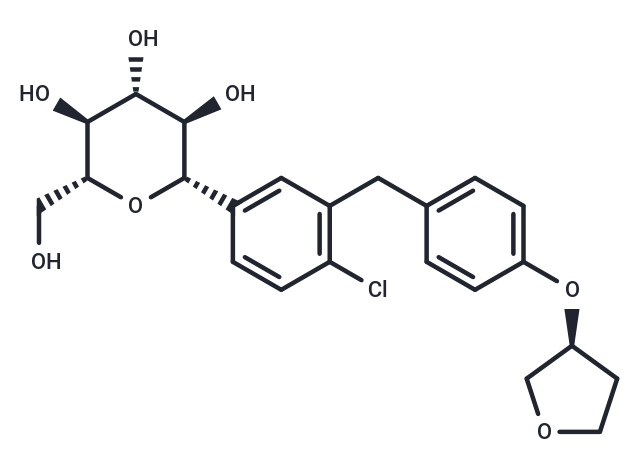Shopping Cart
- Remove All
 Your shopping cart is currently empty
Your shopping cart is currently empty

Empagliflozin (BI 10773) is an SGLT-2 inhibitor (IC50=3.1 nM) that is potent and selective, with more than 300-fold selectivity for SGLT-1/4/5/6. Empagliflozin is used for the treatment of type 2 diabetes.

| Pack Size | Price | Availability | Quantity |
|---|---|---|---|
| 5 mg | 37 € | In Stock | |
| 10 mg | 52 € | In Stock | |
| 50 mg | 68 € | In Stock | |
| 100 mg | 92 € | In Stock | |
| 200 mg | 139 € | In Stock | |
| 500 mg | 188 € | In Stock | |
| 1 g | 277 € | In Stock | |
| 1 mL x 10 mM (in DMSO) | 40 € | In Stock |
| Description | Empagliflozin (BI 10773) is an SGLT-2 inhibitor (IC50=3.1 nM) that is potent and selective, with more than 300-fold selectivity for SGLT-1/4/5/6. Empagliflozin is used for the treatment of type 2 diabetes. |
| Targets&IC50 | SGLT2:3.1 nM |
| In vitro | In kinetic binding experiments, [3H]-Empagliflozin exhibited high affinity for SGLT-2 in the absence of glucose, demonstrating an average Kd of 57 nM and a half-life of binding to SGLT-2 of 59 minutes. Empagliflozin competitively binds to SGLT-2 against glucose. The selectivity of Empagliflozin for hSGLT-2 was substantially higher compared to other glucose transporters: 2500 times greater than hSGLT-1 (IC50 8300 nM), over 3500 times that of hSGLT-4, more than 350 times that of hSGLT-5 (IC50 = 1100 nM), and over 600 times that of hSGLT-6. Additionally, at a concentration of 10 μM, Empagliflozin did not inhibit GLUT1. |
| In vivo | Long-term treatment with Empagliflozin can improve blood glucose control and characteristics of metabolic syndrome in diabetic rats. After treating dogs with 5 mg/kg Empagliflozin for 24 hours, plasma concentrations were over 100 times higher than the measured IC50 value. The total plasma clearance rate for Empagliflozin in ZDF rats was 43 mL/min/kg, compared to 1.8 mL/min/kg in dogs. The Cmax for ZDF rats and dogs treated with Empagliflozin were respectively 167 nM and 17254 nM. Additionally, the bioavailability of Empagliflozin in ZDF rats was 33.2%, whereas it reached up to 89.0% in dogs. |
| Kinase Assay | [14C]-monosaccharide uptake inhibition experiments: Stable cell lines over-expressing hSGLT-1, -2, -4, -5 or -6 or rSGLT-1 or -2 are used for the sodium-dependent monosaccharide transport inhibition assay. Cells are pre-incubated in 200 μL uptake buffer (10 mM HEPES, 137 mM NaCl, 5.4 mM KCl, 2.8 mM CaCl2, 1.2 mM MgCl2, 50 μg/ml Gentamycin, 0.1% BSA) for 25 minutes at 37°C. 10 μM Cytochalasin B and test compound is added at different concentrations 15 minutes before the initiation of the uptake experiment. The uptake reaction is started by the addition of 0.6 μCi [14C]-labelled monosaccharide i.e. [14C]-labelled AMG, glucose, fructose, mannose or myo-inositol, in 0.1 mM AMG (or the respective non-radioactive monosaccharide). After incubation for 60 minutes (hSGLT-5), 90 minutes (hSGLT-4) or 4 hours (hSGLT-2) at 37°C, the cells are washed three times with 300 μL PBS and then lysed in 0.1 N NaOH with intermittent shaking for 5 minutes. The lysate is mixed with 200 μL MicroScint 40 and shaken for 15 minutes and counted for radioactivity in the TopCount NXT. For SGLT-4 and SGLT-5 assays cells are pre-incubated in pre-treatment buffer (uptake buffer containing choline chloride instead of NaCl) for 25 minutes prior to addition of uptake buffer. |
| Cell Research | MTS assay(Only for Reference) |
| Alias | BI 10773 |
| Molecular Weight | 450.91 |
| Formula | C23H27ClO7 |
| Cas No. | 864070-44-0 |
| Smiles | O[C@H]1[C@H](C2=CC(CC3=CC=C(O[C@H]4CCOC4)C=C3)=C(Cl)C=C2)O[C@H](CO)[C@@H](O)[C@@H]1O |
| Relative Density. | 1.398 g/cm3 |
| Storage | Powder: -20°C for 3 years | In solvent: -80°C for 1 year | Shipping with blue ice. | ||||||||||||||||||||
| Solubility Information | 10% DMSO+40% PEG300+5% Tween 80+45% Saline: 8.3 mg/mL (18.41 mM), In vivo: Please add the solvents sequentially, clarifying the solution as much as possible before adding the next one. Dissolve by heating and/or sonication if necessary. Working solution is recommended to be prepared and used immediately. DMSO: 55 mg/mL (121.98 mM) Ethanol: < 1 mg/mL (insoluble or slightly soluble) | ||||||||||||||||||||
Solution Preparation Table | |||||||||||||||||||||
DMSO
| |||||||||||||||||||||

Copyright © 2015-2024 TargetMol Chemicals Inc. All Rights Reserved.